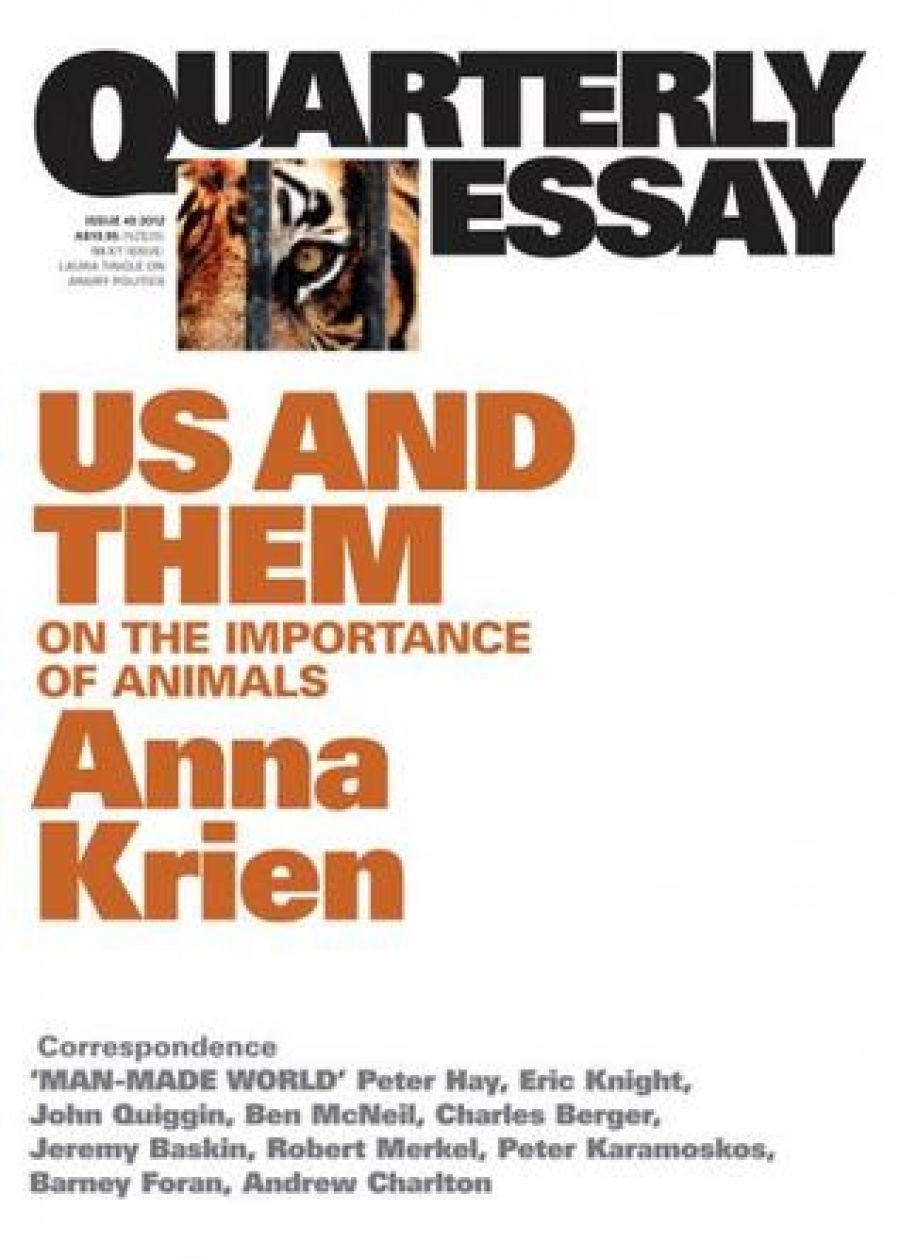
- Free Article: No
- Contents Category: Journal
- Review Article: Yes
- Article Title: The small and the equivocal
- Online Only: No
- Custom Highlight Text:
Whether the focus is on Japanese whaling or the slaughter of livestock in Indonesia, the Australian public has strong views on how animals should be treated abroad – less so when the problem is closer to home. Anna Krien’s Quarterly Essay is an incisive narrative account of our ‘nuanced and often contradictory relationship’ with animals: ranging from the live cattle trade to our use of primates in science, to our attempts to control native wildlife populations through cyclical breeding and culling.
- Book 1 Title: Us and Them
- Book 1 Subtitle: On the importance of animals (Quarterly Essay 45)
- Book 1 Biblio: Black Inc., $19.95 pb, 125 pp
Krien begins her investigation with a bold assertion: deep down, she argues, we know our treatment of animals is unjust. The real question is ‘just how much of this injustice are we prepared to live with?’ The answer, it seems, is anything but clear.
Us and Them: On the Importance of Animals is divided into the three areas of critical concern for animal rights: eating, testing, hunting. In the first, ‘Killing’, Krien travels to Jakarta, exploring the abattoirs and cattle markets that were the principal focus of a confronting exposé on Four Corners, ‘Bloody Business’ (May 2011). The resulting one-month moratorium on the live export of cattle to Indonesia appears – in light of recent footage by Animals Australia – to have had only a temporary effect. The Age reports that the banned Mark 1 ‘trip’ boxes – from which cows frequently escape, their ‘hooves clumsily ice skating out from beneath them, legs getting caught in gutters and snapping’, before they are eventually brought down and crudely killed – are still in use across parts of Indonesia.
The startling irony was that the initial controversy coincided with Labor’s pained attempt to secure its people-laundering deal, the so-called ‘Malaysian Solution’. One bewildered human rights campaigner wryly mused that our animal exports and asylum seekers would be ‘ships passing in the night’ (semaphoring the government’s rash populism between them, presumably).
In Indonesia, Australia has made long-term commitments to the local market and its consumers. ‘We are now, officially, in a bind,’ Krien avers; ‘we’ve created the demand.’ To bring the trade to a standstill would eventually affect Indonesian and Brazilian rainforests, for the loss of Australian livestock would certainly be recouped elsewhere. Krien ponders: ‘Are we better off staying in the game and educating developing countries about animal welfare, while at the same time assisting them to introduce industrialised methods of factory farming, a practice that we are ourselves are increasingly finding abhorrent?’ Krien, reserve being one of her strengths, offers no clear answer.
As Peter Mares wrote in his review of Krien’s book Into the Woods: The Battle for Tasmania’s Rainforests (ABR, November 2010), while ‘her standpoint can often be rather inchoate’, it is a condition of her honest attempt to level with the reader: to admit her ambiguities on complex issues. One of the most intriguing elements in her Quarterly Essay is the self-conscious choice to be coy about the minutiae and statistics that commonly make up – and often weigh down – similar treatises on animals. Here is one example: the estimated one hundred million animals that are used in scientific tests worldwide each year, and their subsequent expendability when compared with the kind of scrutiny that a new cosmetic or soft drink demands (‘It is difficult to pinpoint,’ Krien writes, ‘exactly when animals in the laboratory went from being indispensable to disposable objects.’) Instead, Krien imagines a high school debate in which these facts are put into the voice of a nervous and asthmatic young woman who represents the ‘against’ team on the question of whether we should use animals in testing – Krien’s puisne Elizabeth Costello, as it were.
The need to adopt a masquerade, when discussing our relationship with the natural environment, speaks to the inadequate nature of using statistics alone to describe issues that are intensely felt. It recalls a similar question Krien posed about the fight for Tasmania’s native forests in Into the Woods: ‘For an issue that they say is purely economic, why does it seem so emotional?’
While I was writing this review, a pigeon became trapped in my apartment’s foyer. The bird was clearly sick, unwilling to move, plumage withering. I debated whether to carry it to a nearby vet. If it were a companion animal, surely it would be unethical of me to deny it treatment. Despite being a vegan for the better part of a decade, I dithered. Next day it had vanished. I realised that I care, but not enough – not always. These are the types of choices that echo throughout Krien’s wonderfully adept essay: the small and the equivocal. We are left to decide how consequential they should be. As Krien frames the common disposition: ‘It seems most of us have a minor clause inside of us on the treatment of animals – a “that’s not allowed” but “that’s okay.” We have our limits and our permissions.’
Perhaps our relationship with animals is simply sui generis: an exchange that insists on its many contradictions, its lack of clear distinction between fauna, friend, and food. Perhaps the way in which we relate to animals is more instinctive than the intellectual choice we often pretend it is – a unifier between the species if ever there was one.


Comments powered by CComment